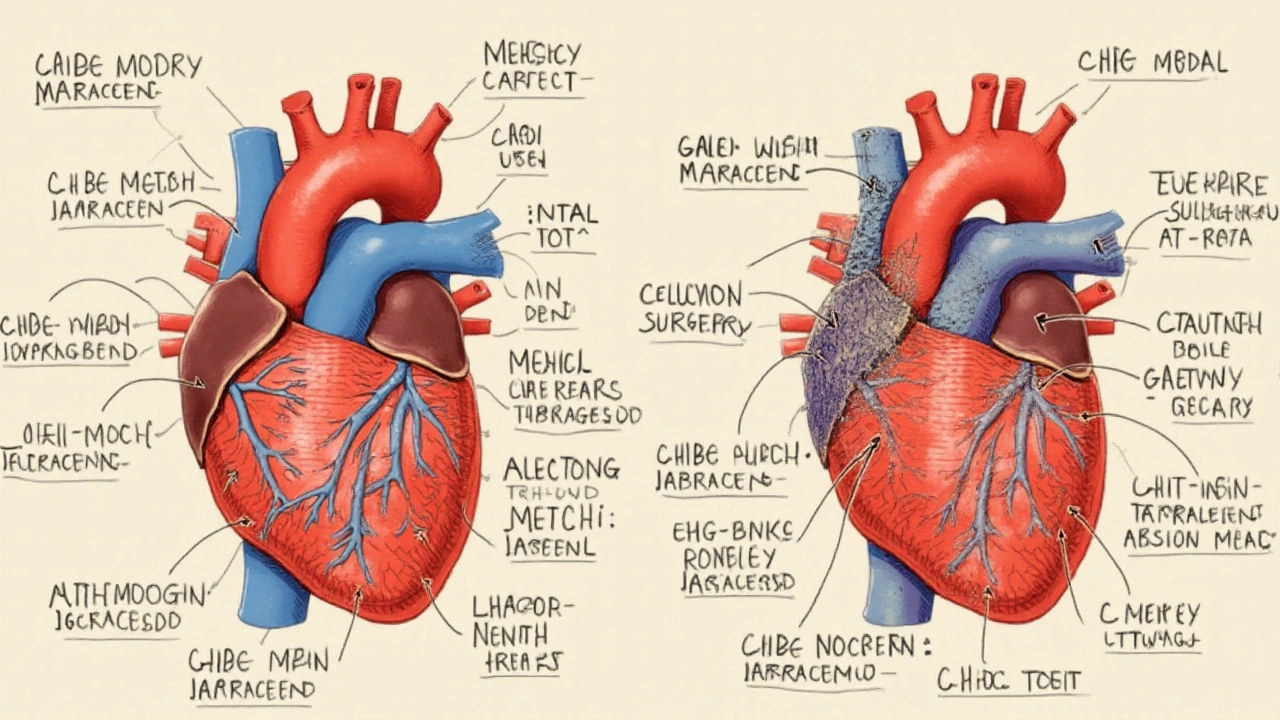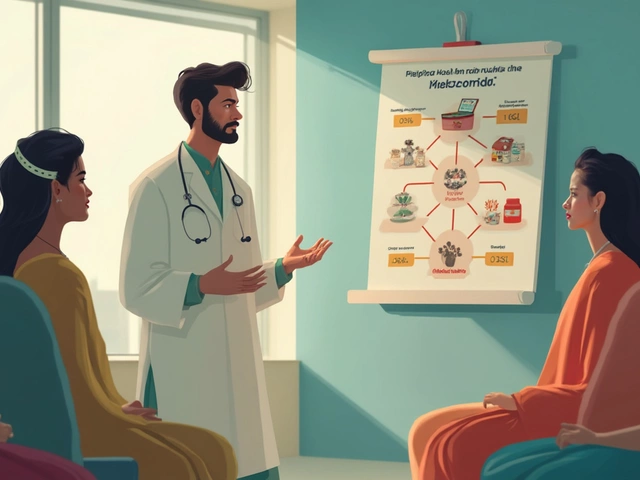Heart surgery is an intricate field within medicine, reflecting both the marvels of modern science and the challenges it faces. With the heart being a vital organ, operations performed on it require precision, expertise, and state-of-the-art technology.
Despite the progress made in surgical techniques, certain heart procedures are notoriously known for their high failure rates. These failures can be due to a combination of technical, medical, and patient-specific variables.
This discussion delves into the realities of cardiac surgeries, spotlighting why some procedures experience more setbacks than others and what is being done to mitigate these risks in the future.
- Introduction to Heart Surgeries
- Common Heart Surgeries and Challenges
- Factors Contributing to Failed Surgeries
- Patient Care and Postoperative Measures
- Future of Cardiac Surgery
Introduction to Heart Surgeries
Heart surgeries stand as the cornerstone of modern cardiology, orchestrating a complex symphony of human ingenuity and technological prowess. The unfolding journey from the first historical attempts at treating heart ailments to the advanced surgical procedures of today reflects the incredible evolution of the medical field. In essence, heart surgery encompasses a wide array of procedures that address structural and functional disorders of the heart, ranging from the simpler operations like angioplasty to more intricate ones like coronary artery bypass grafting and heart transplants.
Each of these procedures carries its unique set of risks and challenges. The heart, with its intricate network of vessels and chambers, offers no room for error. Surgeons must navigate this delicate maze, employing both skill and precision with the utmost care. Interestingly, statistics reveal that the success rates of cardiac surgeries have improved dramatically over the years, with survival rates surpassing 95% for certain procedures. However, not all surgeries boast such outcomes, primarily due to the complexity involved and patient health conditions. As per the American Heart Association, the demand for cardiac surgical interventions is anticipated to rise with the aging population, necessitating even more refined techniques.
Despite the progress, the risks are real. Dr. Alice Roberts, a leading cardiologist, once stated, "Every heart surgery is a calculated risk, a delicate balance between the patient's existing health conditions and the skill of the team."
The advancements in surgical tools, imaging technology, and postoperative care continue to redefine what's possible in cardiac surgeries. Despite significant advancements, a number of factors still contribute to the failures of these procedures. Patient-related risks, such as age, pre-existing conditions, and lifestyle choices, play a pivotal role in outcomes. Technological failures, though less common, are yet another critical aspect to consider. In light of these factors, the medical community remains committed to researching innovative methods to enhance success rates and patient recovery.
The evolution of surgical techniques and materials has also led to groundbreaking accomplishments across the board. Minimally invasive surgeries, for instance, have paved the way for reduced recovery times and lower infection risks. As these techniques evolve, so does the hope for phasing out the notion of certain surgeries being "high-risk," addressing the high failure rates often associated with complex cardiac operations.
Common Heart Surgeries and Challenges
One of the most familiar types of heart surgery is the coronary artery bypass grafting (CABG). This procedure is performed to improve blood flow to the heart in individuals suffering from severe coronary artery disease. CABG involves taking a healthy artery or vein from another part of the body and grafting it to the blocked coronary artery. It has been a milestone in cardiac treatment, yet it comes with its own set of complications. Potential issues may arise from bleeding, infection, or even an irregular heartbeat post-surgery. Surgeons continuously refine their methods to reduce these risks, using techniques that make each surgery as safe as possible.
Valve repair or replacement is another noteworthy procedure in the realm of cardiac surgeries. This is often necessary when valves do not open or close properly, affecting blood flow through the heart. Surgeons may decide between repairing the existing valve or replacing it with a mechanical or biological substitute. While mechanical valves are quite durable, they come with the downside of necessitating lifelong anticoagulant use. On the other hand, biological valves, generally derived from animal tissues, have a shorter lifespan, which may require additional surgeries in the future. Patients are involved in the decision-making process, weighing the pros and cons of the options available.
“The decision of whether to repair or replace a valve is sometimes more of an art than a science,” says Dr. Jane Smith, a leading cardiologist.
Atrial fibrillation, a common heart rhythm problem, can also require surgical intervention. Minimally invasive techniques, such as catheter ablation, are used to destroy small areas of heart tissue that cause irregular rhythms. Despite its minimally invasive nature, the procedure isn't without challenges. The success rates vary based on the complexity of the atrial fibrillation, and some patients may experience recurring episodes, necessitating additional treatment sessions. The development of more sophisticated technology, such as advanced mapping systems, seeks to enhance the precision and effectiveness of these interventions to improve patient outcomes.
Congenital heart defects often require correction through surgical means, sometimes at a very young age. Each defect is unique, and so are the surgical approaches. The goal is to repair or correct the defect, allowing the heart to function as normally as possible. However, surgeries in young children or infants come with heightened risks, including complications with anesthetic management and the delicate nature of the tiny heart structures. As medical science evolves, new techniques and materials are being developed to improve the safety and efficacy of these procedures, offering hope to many families worldwide.

Factors Contributing to Failed Surgeries
The realm of heart surgery is fraught with uncertainties and demands a high degree of precision. Despite the advancements in medical tech and surgical methods, heart surgery remains one of the most challenging procedures, which sometimes leads to failure. There are several key factors that contribute to these unfortunate outcomes, each playing a significant role in the success or failure of a surgery. One of the primary reasons is the complex nature of the heart itself. Something as intricate as the human heart requires a deep comprehension of its unique anatomical features and functions, making it prone to errors during surgery.
In addition to anatomical challenges, patient-specific factors also significantly affect the outcome of a cardiac operation. Each individual's health profile is unique, comprising factors such as age, overall fitness, pre-existing conditions, and genetics, all influencing how well a patient might cope during and after the surgery. Older patients or those with comorbidities like diabetes or hypertension may naturally face greater risks during cardiac procedures.
Another crucial aspect lies in the surgical team and hospital environment. The expertise of the surgical team, their experience particular to certain procedures, and the quality of pre and postoperative care provided by the hospital can dramatically alter surgical success rates. Even the best surgeons are reliant on a competent support team, state-of-the-art equipment, and sterile conditions to minimize the risk of complications like infections. A report by the World Health Organization highlighted that approximately 234 million major surgeries are conducted worldwide annually, with a significant strain on health resources affecting outcomes.
Moreover, technology, while a boon, can also become a pitfall. The incorporation of advanced machinery and surgical tools requires a learning curve and absolute precision, and any technological malfunctions or misuse could lead to fatal results. Despite being meticulously crafted, medical equipment is only as good as its operator. An alarming reminder of this was underscored during a medical conference where an experienced cardiologist shared insights into how modern surgical tools could both save and complicate lives if not handled correctly.
"Even with cutting-edge technology, the surgeon's skill and decision-making remain the cornerstone of successful heart surgeries," asserted Dr. Kavitha Sethi, a renowned cardiologist.
In recognising these factors, it’s imperative for potential patients to be well-informed and seek facilities known for their expertise in heart surgery. It’s important for them to engage in a detailed discussion with their healthcare providers about the risks involved, and to follow all recommended health protocols, both preoperatively and postoperatively. In essence, while the specter of surgical failure might loom over, awareness and preparedness can significantly tilt the balance towards a favorable outcome.
Patient Care and Postoperative Measures
Effective patient care is absolutely crucial in the realm of heart surgery, serving as a foundational stone for successful recovery. Postoperative care begins the moment the patient exits the operating room. A multidisciplinary team of healthcare professionals carefully monitors vital signs, making sure that the heart's rhythm remains steady, while blood pressure is closely regulated. Immediate care during this phase is vital to counteract any surgical complications that may arise, such as bleeding or irregular heartbeat, commonly known as arrhythmia.
Nutrition plays a monumental role in recovery. A balanced diet, often tailored on a case-by-case basis, is recommended to boost the immune system and aid in tissue repair. Foods rich in antioxidants, vitamins, and lean proteins are typically emphasized. This helps ensure that patients regain their health swiftly and reduces the risk of postoperative infections. Hospitals often employ nutritionists specifically for this purpose, underscoring the importance of diet in heart surgery recuperation.
Physical activity, albeit limited at first, is integrated into the recovery plan. Light exercise encourages blood flow and aids in preventing complications such as blood clots. Initially, a patient may only be encouraged to engage in simple leg lifts while in bed or short walks in the hospital corridors. As recovery progresses, these activities gradually intensify in consultation with healthcare professionals, ensuring they match the individual's stamina and health status.
Pain management is another focal point, with the primary aim to maintain comfort while balancing the need to minimize opioid use. Non-opioid pain relievers are often the first line of defense, though stronger medications may be prescribed if necessary. Non-pharmaceutical interventions, ranging from relaxation techniques to physiotherapy, are actively encouraged to further aid in pain reduction.
Dr. Emily Richardson from the Global Health Institute emphasized, "Postoperative care is the bridge that ensures surgeries transform into stories of healing rather than statistics of failure."
Emotional and psychological support is vital as well. Heart surgery can be a daunting experience, often accompanied by feelings of anxiety or depression. Hospitals usually provide access to counseling services and support groups, helping patients navigate the emotional complexities of such a significant health event. Comprehensive support networks, including family involvement, are strongly emphasized to enhance the patient's psychological resilience.
A meticulous follow-up schedule is also a staple of heart surgery aftercare. Regular appointments with cardiologists and surgeons involve tests to monitor heart function, using tools such as echocardiograms and stress tests. These evaluations ensure that the heart is healing appropriately, and any abnormalities are swiftly identified and addressed.
Table of common postoperative measures:
| Measure | Purpose |
|---|---|
| Nutrition | Boosts recovery and strengthens the immune system. |
| Physical Activity | Encourages circulation and prevents clot formation. |
| Pain Management | Ensures patient comfort while minimizing drug dependency. |
| Psychological Support | Addresses anxiety and depression, promoting holistic healing. |
| Follow-Up Appointments | Monitors heart health and identifies issues early. |
By synthesizing these various aspects of care, the likelihood of failed surgeries can be significantly reduced, creating an environment conducive to healing and enhanced quality of life for patients.

Future of Cardiac Surgery
The future of heart surgery is shaped by impressive advances in technology and a profound understanding of cardiac conditions. Robotics is already revolutionizing the field, offering precision that human hands alone cannot achieve. Robotic-assisted surgeries allow surgeons to perform intricate procedures through minuscule incisions, reducing recovery times and minimizing risks associated with traditional open-heart surgeries. The use of artificial intelligence in the operating room is beginning to assist in real-time decision-making, analyzing patient data instantly to provide insights that help ensure better outcomes.
Another significant stride in cardiac care is the development of bioengineered heart tissues. Researchers are exploring the possibilities of using stem cells to regenerate heart muscles, potentially reducing the need for heart transplants in patients with heart failure. This could be a game-changer for those on long waiting lists for donor hearts. In the coming years, we can expect breakthroughs in the way these technologies are applied, making surgeries more efficient and accessible to a wider range of patients.
"The future of cardiac surgery is incredibly promising, with emerging technologies paving the way for less invasive, more effective procedures," says Dr. Mathew Jones, a leading cardiologist involved in groundbreaking research.
Additionally, the advent of personalized medicine is beginning to play a pivotal role. Genetic testing and advanced imaging techniques are enabling clinicians to tailor surgical interventions to the unique genetic makeup of each patient. This customization not only enhances the success rates of surgeries but also minimizes potential postoperative complications.
Virtual reality (VR) and augmented reality (AR) are emerging as valuable educational tools in this field, providing surgeons with the ability to practice complex procedures in a risk-free environment. This training means that when they enter the operating room, they are better prepared and informed. These simulations also enable the visualization of heart anatomy in 3D, offering a level of detail that is assisting in precise operational planning.
The integration of telemedicine into cardiac care is another trend worth mentioning. Telemedicine enables cardiologists to monitor patients remotely, adjusting medications and advising lifestyle changes without the need for frequent hospital visits. This accessibility not only improves patient experience but has demonstrably positive impacts on health outcomes by ensuring continuous care.
Innovations in materials science have led to the development of better-performing implants and devices such as synthetic valves and pacemakers that are more biocompatible and have longer lifespans. These improvements decrease the likelihood of the body rejecting them and reduce the need for replacement surgeries, significantly improving the quality of life for patients.
With these advancements, the future of cardiac surgery looks increasingly optimistic. Both the healthcare industry and patients stand to benefit immensely as these technologies become more prevalent and sophisticated, heralding a new era of cardiac care that wasn't imaginable just a few decades ago.





